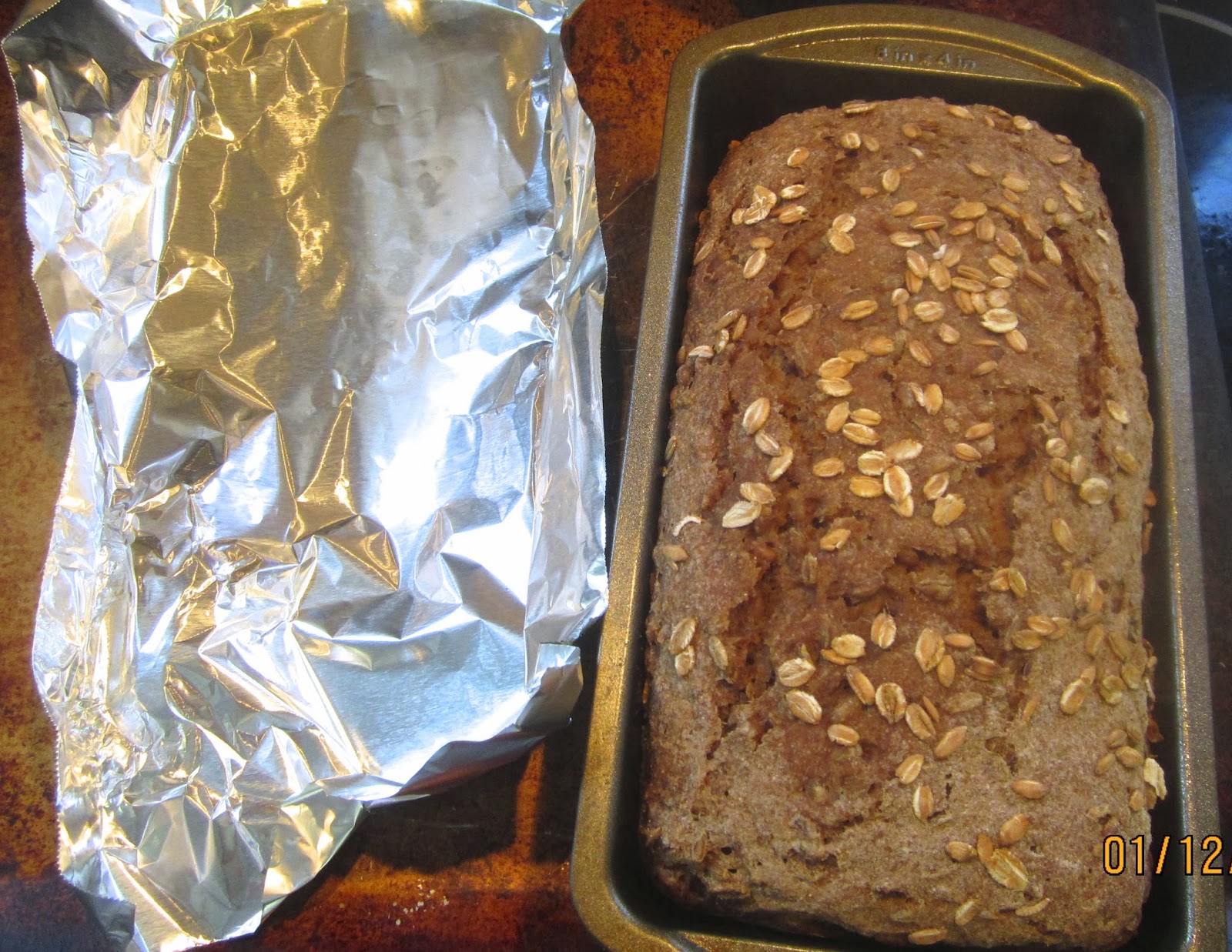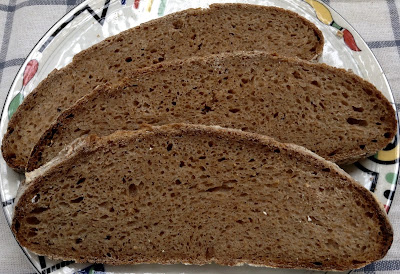 Hier geht's zur deutschen Version dieses Posts (folgt noch)
Hier geht's zur deutschen Version dieses Posts (folgt noch) When I started my little home based bakery, I wanted to offer a typical German Schwarzbrot. Though "schwarz" means "black", a Schwarzbrot doesn't have to be a 100% rye bread, only most of the flour should be rye.
With Peter Reinhart's pre-dough method from "Whole Grain Breads" in mind, I cobbled together different recipes into one I could work with. Baking this bread often (my customers love it!) I played with the formula around, and, over the years, tweaked it so much, that it became entirely my own.
It contains whole rye berries, has a little bit of sweetener, but, also, a pleasant natural sweetness, and it is not artificially colored with large amounts of molasses, cocoa, coffee or other additives.
People familiar with my blog know that I'm very much in favor of long fermentation. Breads that are allowed to ripen slowly are much better digestible, and long fermentation reduces the discomfort that gluten may cause for some.
 |
| We enjoy Schwarzbrot with ham or other cold cuts, but also with honey |
But most important for me - the taste of most breads improves significantly if flavors have more time to develop.
Scarred by my father's strict enforcement of daily Schwarzbrot consumption as a child - "Schwarzbrot macht Wangen rot!" (black bread makes your cheeks red!) was his motto - I never cared too much for dark ryes.
But, overcoming my early Schwarzbrot trauma, I love this hearty, crunchy bread and always bake an extra one for my family, when I make it for my customers. We like it with all kinds of cold cuts, Fleischsalat (German meat salad) and, also with an aromatic honey.
KARIN'S GERMAN SCHWARZBROT
Rye Berries
150 g rye berries
water, for soaking
Soaker
150 g whole rye flour
5 g salt
113 g water
Starter
40 g whole wheat mother starter (75% hydration)
116 g whole wheat flour
83 g water, lukewarm
Final dough
all cooked rye berries
all soaker and starter
37 g whole wheat flour
3 g instant yeast
11 g salt
15 g molasses
3 g honey
rolled rye or sunflower seeds, for topping
DAY 1 (afternoon)
In a bowl, cover rye berries with at least 1 inch/2.5 cm cold water and let them soak for 24 hours.
 |
| Drain rye berries - reserve the soaking water to water your plants! |
DAY 2
In the morning, stir together soaker ingredients until all flour is hydrated. Cover with plastic wrap and leave at room temperature.
Combine all starter ingredients until all flour is hydrated, then knead (using stand mixer or wet hands) for 2 minutes. Let rest for 5 minutes, then knead again for 1 minute. Cover with plastic wrap and leave at room temperature.
 |
| Cook soaked rye berries in fresh water for half an hour |
Place berries in strainer to drain, cover, and let cool to room temperature. (Cooked berries can be kept at room temperature for 24 hours.)
 |
| Schwarzbrot is made with a whole wheat starter |
In the evening, combine all final dough ingredients in mixer bowl and mix at low speed with paddle for 2 minutes. Continue kneading (paddle or dough hook) at medium-low speed for 4 minutes. Dough will be soft and sticky.
Let dough rest for 5 minutes, then resume kneading for 1 minute more. The dough will still be somewhat sticky. Transfer dough to lightly oiled container. Mist with oil, cover, and refrigerate overnight.
 |
| The dough has risen overnight in the fridge |
DAY 3
Remove dough from refrigerator 2 hours before using, to warm up.
Preheat oven to 450ºF/230ºC. Spray loaf pan (8 1/2" by 4"/22 cm x 10 cm) with oil.
 |
| Loosening the slightly sticky dough with a spatula |
Transfer dough to a lightly floured work surface. (If you used a square container, it is already pre-shaped.)
 |
| Practically pre-shaped (from the container)... |
 |
| ....rolling it into a sandwich loaf is easy |
Roll dough into a sandwich loaf and place it into the pan, seam side down. Mist with water, sprinkle with rolled rye or sunflower seeds, pressing them a bit down with your hands to attach, then spray with oil.
Cover pan loosely with aluminum foil, don't let the bread rise anymore!
 |
| Covered loosely with foil, the bread is ready for the oven (no second rise!) |
Place pan in oven, reduce temperature to 425ºF/220ºC and bake it for 35 minutes. Take loaf out of the oven, remove aluminum foil, loosen the sides from pan with a spatula, and turn the half-baked bread out onto a baking sheet.
 |
| Remove foil from half-baked bread, and turn it out onto a baking sheet |
Return bread to the oven to bake for about 30 minutes longer. It should be crisp, and register at least 200ºF in the center.
Transfer bread to cooling rack, mist with water while hot, and let it cool. For the first 24 hours, keep it in a brown paper bag to allow it to continue drying out and developing flavor. After that, it can be wrapped in aluminum foil. (Don't keep it in the refrigerator!).
 |
| A very popular bread in my bakery |
BreadStorm users (also the free version) can download the formula:
Ginger (from Ginger & Bread) made a lovely version of this bread: http://gingerandbread.com/2016/01/28/karins-german-schwarzbrot/















